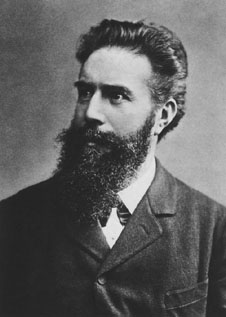| Wilhelm Conrad Röntgen  Born: 27-Mar-1845 Born: 27-Mar-1845
Birthplace: Lennep, Germany
Died: 10-Feb-1923
Location of death: Munich, Germany
Cause of death: unspecified
Remains: Buried, Alter Friedhof, Giessen, Germany
Gender: Male
Race or Ethnicity: White
Sexual orientation: Straight
Occupation: Physicist Nationality: Germany
Executive summary: Discovered X-Rays German physicist, born at Lennep on the 27th of March 1845. He received his early education in Holland, and then went to study at Zürich, where he took his doctor's degree in 1869. He then became assistant to Kundt at Würzburg and afterwards at Strassburg, becoming privat-docent at the latter university in 1874. Next year he was appointed professor of mathematics and physics at the Agricultural Academy of Hohenheim, and in 1876 he returned to Strassburg as extraordinary professor. In 1879 he was chosen ordinary professor of physics and director of the Physical Institute at Giessen, whence in 1885 he removed in the same capacity to Würzburg. It was at the latter place that he made the discovery for which his name is chiefly known, the Röntgen rays.
In 1895, while experimenting with a highly exhausted vacuum tube on the conduction of electricity through gases, he noticed that a paper screen covered with barium platinocyanide, which happened to be lying near, became fluorescent under the action of some radiation emitted from the tube, which at the time was enclosed in a box of black cardboard. Further investigation showed that this radiation had the power of passing through various substances which are opaque to ordinary light, and also of affecting a photographic plate. Its behavior being curious in several respects, particularly in regard to reflection and refraction, doubt arose in his mind whether it was to be looked upon as light or not, and he was led to put forward the hypothesis that it was due to longitudinal vibrations in the ether, not to transverse ones like ordinary light; but in view of the uncertainty existing as to its nature, he called it X-rays.
For this discovery he received the Rumford medal of the Royal Society in 1896, jointly with Philipp Lenard, who had already shown, as also had Heinrich Hertz, that a portion of the cathode rays could pass through a thin film of a metal such as aluminum. Röntgen also conducted researches in various other branches of physics, including elasticity, capillarity, the conduction of heat in crystals, the absorption of heat-rays by different gases, piezoelectricity, the electromagnetic rotation of polarized light, etc.
Father: (clothmaker and merchant)
Mother: Charlotte Constanze Frowein
Wife: Anna Bertha Ludwig (m. 1872, d. 1919)
Daughter: Josephine Bertha Ludwig (adopted at age 6, in 1887, dau. of Anna's brother)
High School: Institute of Martinus Herman van Doorn (boarding school)
High School: Utrecht Technical School (expelled)
University: University of Utrecht (attended 1865)
University: PhD, University of Zürich (1869)
Professor: Lecturer, Strasbourg University (1874)
Professor: Academy of Agriculture at Hohenheim, Württemberg (1875)
Professor: Strasbourg University (1876-79)
Professor: Physics Chair, University of Giessen (1879-88)
Professor: Physics Chair, University of Würzburg (1888-1900)
Professor: Physics Chair, University of Munich (1900-20)
Nobel Prize for Physics 1901
Rumford Medal 1896 (with Philipp Lenard)
Matteucci Medal 1896 (with Philipp Lenard)
Expelled from School
Units of Measure gamma radiation (obsolete)
Chemical Element Namesake roentgenium (Rg, 111)
Do you know something we don't?
Submit a correction or make a comment about this profile
Copyright ©2019 Soylent Communications
|